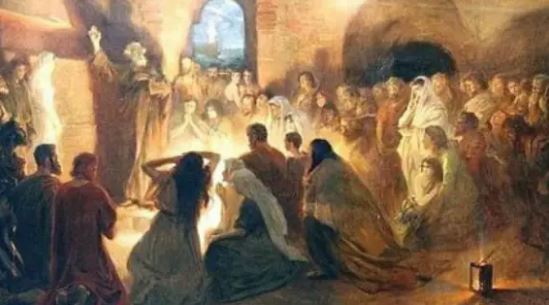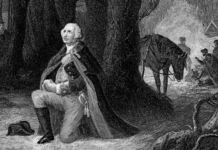(Note: This is a continuation of a previous article. For Part One, click here to read “The Magical Bible Verse That’s Used to Nullify 100 Others”)
We need to understand the immediate context of 2 Peter 3. The entire argument over when the events Peter describes take place comes down to defining the last days, the identity of the scoffers, the expectation of Peter’s audience, the consistent definition of time terms, and how the Bible uses heaven and earth language.
First, Peter, similar to James (1:1), was writing to Jews scattered throughout the Roman Empire, “those who reside as aliens, scattered throughout Pontus, Galatia, Cappadocia, Asia, and Bithynia” (1 Pet. 1:1). As Jews, they were familiar with Israel’s history, promises, and biblical literature. Peter describes their time as “these last times” (1:20). He connects the Old Covenant passing way with the New fulfilled in the person and work of Jesus Christ (2:4–12). He mentions “the fiery trial among you, which comes upon you for your testing” (4:12)…. For it is time for judgment to begin with the household of God; and if it begins with us first, what will be the outcome for those who do not obey the gospel of God” (4:17). A judgment event was on the horizon that would affect believers and unbelievers “when the Chief Shepherd appears” (5:4). This is not some distant future end-time event.
Second, Peter and other New Testament writers, wrote as though their readers would be alive when Jesus returned (2 Peter 1:19; 3:14; James 5:7–9). Peter wrote the following to his Jewish audience: “Therefore, beloved, since you look for these things, be diligent to be found by Him in peace, spotless and blameless” (2 Pet. 3:14). Are we to believe that they looked forward to being incinerated? I don’t think so.
Let’s compare 2 Peter 3:3–4 with Jude 18 which reads, “‘In the last time there shall be mockers, following after their own ungodly lusts.’” In the next verse, we are told, “These are the ones who cause divisions, worldly, minded, devoid of the Spirit” (Jude 19). Not “will” but “are.” Peter and Jude are not predicting what will happen in the distant future. These things were happening in their day. Just like “false prophets also arose among the people … , there will also be false teachers among you,” Peter told his first readers (2 Pet. 2:1; also 1 John 4:1). “The way of the truth will be maligned” and “they will exploit you with false words” (2 Pet. 2:3). Notice the use of the second person plural (“you”). Peter is issuing a warning to those who received his letter. The entire NT issues warnings against these skeptics and moral trouble makers (Jude 10–16; Acts 20:28–30).
We should not find it unusual, therefore, that Peter would mention scoffers who would mock the faithful that the generation that Jesus said would not pass away before His coming to destroy Jerusalem was about to come to an end and everything remains as it was. These were Jewish scoffers. Peter refers to “the fathers” that have “fallen asleep” (2 Peter 3:4). The use of “fathers” would have made no sense to a gentile audience (e.g, Matt. 23:30, 32; Luke 6:26; 11:47; John 4:20; 6:31; 7:22; Heb. 1:1). You can hear these first-century Jewish scoffers arguing:
The temple is still standing, the priesthood is intact, and animal sacrifices are going on as usual. The old covenant has not passed away; it’s a permanent fixture, even under Roman oppression. People are marrying and giving in marriage, eating and drinking, buying and selling, and planting and building (Luke 17:22–35).[1] Everything is as it was since creation (2 Pet. 3:4). This Jesus, who claimed He would come in judgment before “this generation” passed away (Matt. 24:34), was a false prophet and you Christians are foolish to follow Hhim. Return to the true faith of your fathers.
Similar warnings were given when the land was destroyed by a flood and Sodom was destroyed by fire. The people reacted the same way as the scoffers in Peter’s day. Things looked like they’ve always looked. The scoffers were alive and well in the first century. People have a right to mock and scoff when they read that Jesus was to come within a generation and nearly 2000 years have passed. Liberals mock Christians who don’t believe what Jesus said and then try to make Jesus’ words mean something else.
Preterists don’t doubt God’s Word. We are not end-time scoffers because we take God at His Word when He told us when certain prophetic events would be fulfilled. We believe Jesus when He said He would return in judgment before the generation to whom He was speaking passed away (Matt. 24:34). Preterists marvel when we are accused of “allegorizing” and not interpreting the Bible “literally” and then charged “with such rigid literalism”[2] on the meaning of “this generation.” We believe the Bible when it says that Jesus would come before the last disciple died (16:27–28; John 21:18–23). We believe John when he wrote that “many antichrists” had arisen in his day which served as ample evidence to his readers that it was “the last hour” (1 John 2:18). We agree with the writer to the Hebrews that the day was “drawing near” for first-century Christians (Heb. 10:25). We affirm along with James when he told his readers that “the coming of the Lord is at hand” for them (James 5:8) and that “the Judge is standing right at the door” (5:9; cf. Matt. 24:33). He must be a tired judged if he’s still standing after nearly 2000 years!
The language of 2 Peter 3 is certainly apocalyptic and world ending, but is Peter describing the end of the space-time universe as we generally conceive it, or is he describing the end of a specific type of world? Peter writes that the “world (kosmos) at that time was destroyed” (2 Peter 3:6). But the physical world was not destroyed. When Noah and his family left the ark, the physical world was still there. Peter is using “world” in a cultural, world-and-life-view sense, in terms of what people believed and how they acted on those beliefs. In the case of Noah’s time, his world had fallen into the depth of sin and corruption, and it needed to be destroyed. The people had made “friendship with the world” (James 4:4) a priority. The use of “world” is not the physical world. Consider this passage:
If you were of the world, the world would love its own; but because you are not of the world, but I chose you out of the world, because of this the world hates you (John 15:19; also 17:14–16, 18; 1 John 2:15–17).
What world is this? Is it the earth or what some have described as “this world system”?
In 1 Corinthians 7:31, we learn that “the form of this world is passing away.” Paul is not talking about the physical world, but a type of world they had created for themselves.
Andreas J. Köstenberger, Director of Ph.D. Studies and Senior Professor of New Testament and Biblical Languages at Southeastern Baptist Theological Seminary, explains that the Greek word κόσμος (“world”) “in John’s Gospel typically refers to sinful humanity and only rarely to material creation. It embraces all of humanity, both Jew and Gentile, which sets itself in opposition to God.”[3] D.A. Carson, in his commentary on John’s Gospel, writes, “The ‘world,’ or frequently ‘this world’ (e.g., [John] 8:23; 9:39; 11:9; 18:36), is not the universe, but the created order (especially of human beings and human affairs) in rebellion against its Maker (e.g., 1:10; 7:7; 14:17, 22, 27, 30; 15:18–19; 16:8, 20, 33; 17:6, 9, 14).”[4]
Peter uses “world” (κόσμος) in the same way: God “did not spare the ancient world, but preserved Noah, a preacher of righteousness, with seven others, when He brought a flood upon the world of the ungodly” (2 Peter 2:5). We find a reference to Noah in the gospels in the prophetic message Jesus delivered on the Mount of Olives: “For the coming of the Son of Man will be just like the days of Noah” (Matt. 24:37–39). Those “taken away” were the scoffers who did not heed Noah’s warning. The same thing happened in the lead-up to the destruction of the temple in AD 70.
If Peter’s use of κόσμος means the earth as a physical body, then the statement is untrue. The earth remained. There were the mountains of Ararat before the flood and after the flood (Gen. 8:4). The world remained. It was “the world of the ungodly” that was destroyed. Peter uses the word “world” in a similar way in 2 Peter 3:5–6: “For when they maintain this, it escapes their notice that by the word of God the heavens existed long ago and the land was formed out of water and by water, through which the world [κόσμος] at that time was destroyed, being flooded with water.” “The world at that time” — the world of Noah’s time — was destroyed. But it wasn’t destroyed in the same way that the original heavens and earth were created. The physical earth remained. It did not cease to exist. The world of the Old Covenant was destroyed when judgment was brought upon it by Jesus. It’s interesting that Josephus, the Jewish historian who has given us a picture of ancient Israel as well as the events surrounding the destruction of the temple in AD 70, compares the construction of the tabernacle as the “imitation and representation of the universe” that included the three-fold division of land, sea, and heavens (Josephus, Antiquities of the Jews, 3.7.7).
Owen appeals to Luke 21:34, 36 to support his claim that what Peter states in 2 Peter 3 is what Jesus was referencing in the Olivet Discourse — the “dissolution” of “the Judaical church and state”:
As it was foretold and threatened by Christ. How were believers cautioned to be ready for it with eminent holiness and watchfulness therein! So Luke xxi. 34, 36, “Take heed to yourselves; watch, therefore.” Why so? “Christ is coming,” verse 27. When? “Why in this generation,” verse 32. What to do? “Why, to dissolve heaven and earth,” verse 25; to “dissolve the Jewish church and state. Watch, therefore, give all diligence.” So also Matt. xxiv. 42.
For a study of the meaning of the passing away of heaven and earth in more detail, see “What Does Peter Mean by the Passing Away of Heaven and Earth in 2 Peter 3:10?

Is Jesus Coming Soon?
Readers of Is Jesus Coming Soon? will no longer be bound by the idol of eschatology tradition which has paralyzed the Church and minimized the impact of Christianity on our world. Don’t be disturbed by what you read, because the truth is about to set you free!












